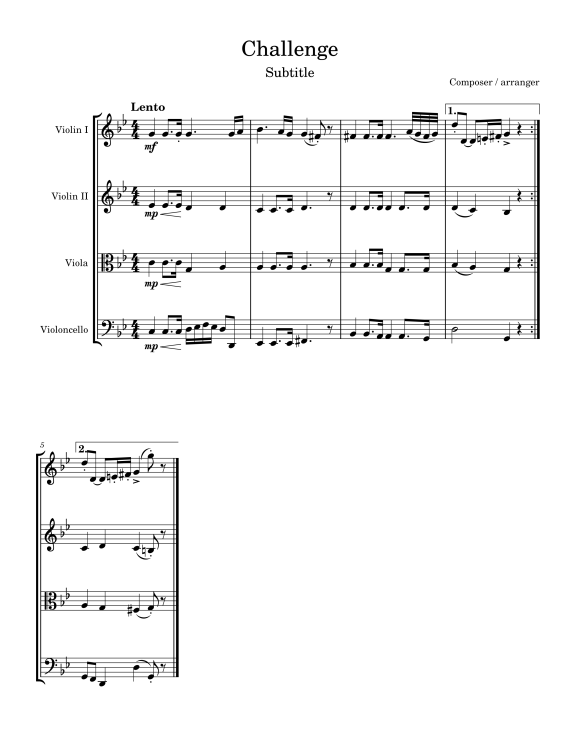
Some Guy That writes Music
Members-
Posts
165 -
Joined
-
Last visited
-
Days Won
12
Some Guy That writes Music last won the day on May 1
Some Guy That writes Music had the most liked content!
About Some Guy That writes Music

- Birthday 10/21/2002
Profile Information
-
Biography
Hi
-
Gender
Male
-
Interests
stuff
-
Favorite Composers
Rachmaninoff, Mussorgsky, Puccini, Tchaikovsky
-
My Compositional Styles
Figuring that out
-
Notation Software/Sequencers
Finale (old), Musescore 4
-
Instruments Played
Baritone (Singer)
Recent Profile Visitors
5,729 profile views
Some Guy That writes Music's Achievements
-
I wouldn’t say anything negative about 5, I more so think a fast 4th (between the current 2nd and 3rd) movement would do a lot of justice to this piece. The last movement you showed has lots of beauty to it, my only consideration is many beautiful movements in a row detracts from their beauty. When you are able to compare the beautiful and the “uglier” movements, it makes those beautiful moments all the more moving, and same with the fast movements. I honestly would gladly listen to any of your current movements in person if I had the chance, they are wonderful. Just because you wrote something that is hard, doesn’t mean its bad, otherwise most of the best music would be no good. I will say one thing, in my opinion (as a vocalist) if you have a solo voice singing with an orchestra, you should utilize the voice at least 60% of the time. This is not something that I’m totally sure everyone will agree with me on but I’ll explain my reasoning. In a concerto or soloist oriented orchestra performance, the soloist must stand infront of the orchestra. Particularly for singers, their job is to emote and show the emotions of the music. When you have a singer on the stage, they are the only face not in their music. They look directly at the audience. Long interludes of 2+ minutes are incredibly difficult to keep the audience’s attention. And if the singers sits and then later stands it cannot be acted through. Film music gets away with the soprano coming in out whenever they want, but I believe this should not happen on stage, simply out of a desire to tell a story, in what I believe, is the most convincing way. I’d be curious on other people’s thoughts on this.
-
I was listening to your work on my phone, when I started texting people, at some point I stopped what I was doing so I could listen to the music. This is rare for me. I think there is some gorgeous music. I personally like the move from 1-3 being calm. But I felt like after that beautiful calmness of 3, you have set-up some anger, or vivace well. The longing of the soprano in the upper range and emotional ending to 3 was great. This tension exists in the first measure of 5, but disappears, I wanted a movement of it. This music made me realize I need to do better lol. Beautiful stuff 5 makes me want to start running on the beach. Idk how else to say it. Also the soprano part sounds a little high. Idk what the range is, but even for a soprano, singing above the staff for a prolonged period of time (a minute straight or more) is quite difficult. High Bs and higher are terrifying for anyone, especially with the orchestra forte underneath, because the soprano can’t cheat or anything. So try to use this range more sparingly if you think you can. Although quite sylistically different from you, one the best composers to look at for easy vocal writing that still uses the full range of the soprano voice would be Donizetti. Take a look at the way he sets up singers for important high notes, I’ll try to find an example when I get home.
-
Op.9 Nr.1 little symphony
Some Guy That writes Music replied to cloud10000's topic in Orchestral and Large Ensemble
Lots of great use of changing colors to keep the same motif interesting. I think it is great as is, but if you were looking to add more, I would love some longer legato lines to add some contrast. -
I actually quite like the strength of the motif for this minute and a half. It just really makes me want a B section. Often times in the renaissance, when there was a crazy polyphonic repetitions like this, they would do 1 of 3 things. Either have another polyphonic section in a different mode, have a more declamatory section of text, which would often be in a "double choir" setting which was back and forth between two homophonic sections, or an outright homophonic section. I think each of these would work really well. Heres an example of Lotti moving from a incredible thick reptitive canon-like polyphonity into a triple-ish choir: https://youtu.be/OZ9dXLmRlpo?si=LaAY263rsR4sFO6x And Gesualdo into a more homophonic style: https://youtu.be/TBC-45-FfVQ?si=Kmqmee2Ldr9aPlYU&t=131 And most was just more polyphony.
-
Some Guy That writes Music started following A kiss - Piece for Symphonic Orchestra , Whale and the Whaler , Exercise in Heavily Modulatory Music and 5 others
-
I wrote this piece with the goal of submitting it to a competition. However I could not get myself to format the music to my preferred level, and a general disdain for the form of the piece, so I decided not to submit it. I have worked quite hard on this piece, bringing out many new textures for myself. But I am at a point where I am too entrenched into this piece to make the large formal changes I want. So I would like to share it with you all. This piece is about a Whale and a Whaling ship, and their corresponding battle, capture of the whale, and bringing it home. I thought this might be an interesting idea for a competition, with a lot of dramaticism inherit, and generally a little easier for a listener to make the connection. Let me know what you think of the piece. I'd love to hear your input on the different textures throughout. I think this piece has some pretty awesome moments and I hope you guys will let me know.
-
Quick little harmony/counter-point mini-challenge :)
Some Guy That writes Music replied to UncleRed99's topic in Challenges
-
Sorry for the technical title, I don't consider this music too technical, that's why I'm keeping it's original name in the file. However for the sake of sharing, this is more of an exercise. Lately I've been upset about the lack of modulations in my music, and so I decided to go to the edge of what I can write, so I could get more comfortable writing in this harmonic style. I generally prefer diatonic music, but love key changes, and would like to improve on making strong moments when keys are changing. This piece is generally in a a very easily felt tone center but there are moments, like page 6, which the motif keep reappearing in different tonal centers, forcing the music to adjust with it. This isn't my best music, the orchestration is fine, and it's not really refined or complex, but this was an important step for me.
-
Hello Young Composers, Today I present a Romance I've been working on for awhile. This is one more of my more edited pieces, I've spent some of the most time on this piece than almost any of my orchestral movements. This piece was written initially with the goal of imitating a Rachmaninoff style Romance. Before you get excited, I can fully say that is not how this piece ended up, but I would still be willing to say this is probably my best piece yet. It's definitely my favorite. I was hoping to save posting this piece until I finished the suite it will be apart of, but I simply have not had the time, motivation, or research to write what I would like. This piece airs on the dramatic side of things. As always criticism is welcome, even if you cannot find the words to make it constructive. I'm especially curious about playability, balance, and formal fluidity.
-
Hello Young Composers, I have finished a project of 4 string quartets, with the goal of getting 4 distinct textures and vibes, 2 slow and 2 fast. 1. Is a broad but brisk quartal and quintal harmonic piece. For nearly the whole piece, it avoids thirds and 6ths, and uses many 4ths, 5ths, and 9ths. 2. is the slowest of the four, and uses double stops for most of the piece, creating a thicker texture. 3. is the fastest of the four, with an emphasis on syncopation and skedaddling melodies. 4. is best described as fight between quartal and triatic harmony Hopefully you enjoy the varied of textures I'm offering. As always I am very open to feedback and criticism, because how else will I get better?
-
Hello Everyone, My name is Izaak Thoms, and I'm a singer. I've been a "professional" (as is in occasionally make money singing) for years at this point, and I am also right now an undergraduate singer in a collegiate program. I've sung with Grammy-nominated ensembles, and other accredited performers. I obviously wouldn't call myself an expert or master at my artform, but I would like to say I have a strong understanding of men's voices especially, but also all voices in general. I've been thinking about this for a while, and would like to just offer my years of work and experience to you wonderful composers. Hopefully those of you who are interested in using me as a resource, can ask me questions about the voice in solo and choral work. And hopefully give you all opportunities to be more successful. Here are three piece that I have performed recently, hopefully this gives you a chance to hear my voice: https://youtu.be/CsCuZRIvmWg https://youtu.be/bK-JrJFqgeA https://youtu.be/XBcOsTt4hyE Things off the top of my head that I know I'll be good at answering: formatting questions, range and tessitura questions, performance questions (concert and staged works), behind the scenes of preparation and performance. And if this thread gets popular enough, I'll likely edit this original post to function as a sort of as a tips and tricks so you might not need to scroll the whole way through.
-
- 1
-

-
I can tell you spent a good bit of time and effort listening and thinking about my piece, and that means alot so thank you for that. I appreciate the specificity of your feedback, especially the notes about fermatas and other formatting suggestions. You feedback is very much respected. As for musescore, one day I realized the sound libraries were on sale, so having just had my paycheck I decided to get “Berlin woodwinds” and “berlin brass” “Cine Percussion” as well as “Cine Strings”. I find that many instruments are out of balance with each other in default musescore. And because of the limited sound editing options (velocity values don’t work with muse score sounds) you have to use dynamics to change volume (rather than some softwares like dorico where you can just make an instrument louder in certain parts of music). These were a game changer, and the $50 i spent on these libraries is a very good in between from Musescore sounds to the nearly $1000 needed for Dorico+Noteperfomer+VSTs. I’m not currently reaching out to any orchestras to perform this, I’ve been looking at some compettions to submit a movement or two but nothing has deadlines soon so I’d rather see what new things I can write. My current goals are to improve until I am satisfied I can write music without limitations (currently my knowledge of harmony and textures feels limited) Once I spend some more time dedicated to improving in these areas, I’ll feel comfortable spending the time advocating for myself to orchestras. I am still very proud of this work, it is many times better than my previous suite I wrote a few months ago. I am taking composition classes this year and next so we will see where those can take me, especially with the focus on chamber works.
-
Thank you Alex, Indeed this took a long time. I started it nearly 2 years ago and composed quite on and off over that time. I appreciate your specific feedback, and I agree, bassoons are awesome! I had a reading session with some woodwinds recently and the bassoon really struck me, especially in the upper register, so I thought I would apply that, and you should see that idea in the last movement as well.
-
This is a piece I've been working on for a little over a year at this point. Originally intended as a suite, it developed into a symphony, with themes that are varied throughout the entire piece. It is the longest, most complex, most varied piece I have written. I am quite proud of it. This piece intends to follow the life of someone who commits a terrible act. Movement 1 is Idolization, the character experiences something that they love, and attempts to reach this idea again and again, but fails. So movement 2 is the Manic continuation of this feeling but now with stronger feelings, and worse intentions. Movement 3 is when the character decides to commit to this terrible act. Movement 4 is the action of committing the act. Movement 5 is the end of the terrible act, and our character, leaving us with nothing. When I wrote this, I was following along with someone in particular, but now I see, it could be many stories, which is why I've kept it general. Enjoy this piece. 00:00 Movement 1 11:16 Movement 2 16:58 Movement 3 27:30 Movement 4 36:54 Movement 5











